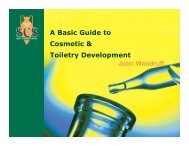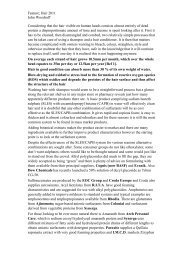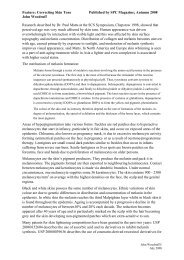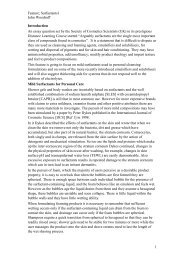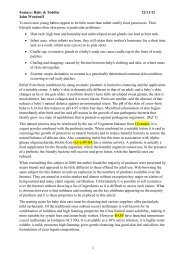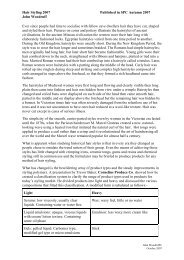Hair Care 2009 - Creative Developments
Hair Care 2009 - Creative Developments
Hair Care 2009 - Creative Developments
You also want an ePaper? Increase the reach of your titles
YUMPU automatically turns print PDFs into web optimized ePapers that Google loves.
<strong>Hair</strong> <strong>Care</strong> <strong>2009</strong> Published in SPC Magazine, Autumn <strong>2009</strong><br />
John Woodruff<br />
<strong>Developments</strong> in hair styling appear to have slowed in recent years. There was only one<br />
presentation dedicated to hair styling at In-Cosmetics and none appear on the programme for<br />
Formulate <strong>2009</strong>. In the USA less than ten patents claiming hair styling compositions have<br />
been granted in <strong>2009</strong> and there was only one presentation on the subject at the IFSCC<br />
Conference, Melbourne, <strong>2009</strong> so has hair styling technology reached its zenith? Following is<br />
a round-up of the more recently introduced styling polymers with emphasis on those suitable<br />
for low VOC sprays and hair gels and also those with multi-functional attributes such as<br />
colour protection.<br />
The presentation at In-Cosmetics was about acrylate hair fixatives sold under the Acudyne<br />
trade name by Rohm and Haas. Acudyne 180 is an aqueous acrylic emulsion polymer that<br />
upon neutralisation yields clear hair spray solutions and crystal-clear films on hair. Hydroxyl<br />
groups enable formulation compatibility with water or aqueous alcoholic systems while also<br />
being humidity resistant in sprays, gels, and mousses. Its minimal effect on viscosity makes it<br />
suitable for pump sprays and low VOC aerosols and it is said not to build-up on the hair.<br />
Acudyne 180 gives optimum film tensile strength and high humidity curl retention when<br />
about 50 to 70% of the polymer acid sites are neutralised with aminomethyl propanol. The<br />
films are very humidity resistant and at 92% relative humidity, the film absorbs only about<br />
0.4% water after 24 hours.<br />
Other Acudyne resins include DHR designed specifically for high performance 55% VOC<br />
aerosol sprays and pumps, said to deliver superior all day flexible hold and shine because of<br />
its unique dual phase combining a soft and a hard acrylic polymer. Acudyne SCP is a styling<br />
conditioning polymer that can be used in gels, mousse, spray gel, lotion and pomades and<br />
LT-120 is suggested for extreme hair styling products, such as, hair gels, styling aids and<br />
sprays because it offers a stiff hold with maximum humidity resistance and does not flake.<br />
Polyquaternium-69 is the basis of Aquastyle 300 from ISP. Although not a new material it is<br />
still worth considering for hydro-alcoholic solutions and it may be used for clear and cream<br />
gels as well as aerosol and non-aerosol mousses, styling lotions, and sprays. In particular it<br />
appears suitable for hair gels and when incorporated at 4% it shows excellent humidity<br />
resistance with retained curl and enhanced shine. Interesting results are obtained if the<br />
Aquastyle 300 is combined in a gel with Carbopol Ultrez 21, which results in crystal clear<br />
gels with a synergistic effect on viscosity after neutralisation. ISP offers over forty styling<br />
and fixing polymers for hair care and further details may be accessed on line [Ref 1].<br />
<strong>Hair</strong> gel science was the subject of the presentation in Melbourne [Ref 2] by Michael Philbin<br />
who described the use of molecular modelling in designing polymers suitable for use in hair<br />
styling systems. Over 5,000 new hair gel polymers were screened using virtual<br />
experimentation that is based on quantitative structure property relationships. This assumes<br />
that a polymer’s properties are derived from its structure and that the different structural<br />
features can be characterized using molecular modelling. The method finds correlations<br />
among these molecular features and the critical product properties. The correlations can be<br />
used to predict the properties of other polymers so candidate polymers can be screened before<br />
making them in the laboratory.<br />
Philbin also described tests performed on gels made with the selected polymers, which<br />
included gel clarity evaluations; hair stiffness and the work required to compress curls treated<br />
with the hair gels, and high humidity style retention tests used to measure long lasting hold.<br />
John Woodruff©<br />
October <strong>2009</strong>
<strong>Hair</strong> <strong>Care</strong> <strong>2009</strong> Published in SPC Magazine, Autumn <strong>2009</strong><br />
John Woodruff<br />
He also described a new flake quantification methodology developed using image analysis to<br />
determine the amount of flaking generated by each gel formulation on hair.<br />
Carbomers are frequently used to produce styling gels but they have limitations because of<br />
incompatibility with cationic materials and they are very sensitive to electrolytes. BASF has<br />
recently launched Luvigel Advanced as a multifunctional cationic rheology modifier that, in<br />
combination with PVP and VP/VA copolymers, it improves setting properties and the overall<br />
performance of the hair styling gel formulation in terms of humidity resistance and low tack.<br />
It is a cross-linked copolymer of vinylpyrrolidone, vinylimidazole, 3-methyl-1-vinyl<br />
imidazolium chloride and methacrylic acid with the INCI name Polyquaternium-86. It is<br />
claimed that the cationic nature of polyquaternium-86 together with its tailor-made shearthinning<br />
rheology provides properties like creamy texture and the ability to re-style the hair<br />
plus excellent combing behaviour without sacrificing gel clarity<br />
BASF produces literature describing its extensive range of styling polymers and this can be<br />
accessed on its web site [Ref 3]. It lists the properties of all twenty-eight polymers with<br />
formulation suggestions for all types of hair products. Among the latest material<br />
introductions Luviflex Silk, INCI: PEG/PPG-25/25 dimethicone/acrylates copolymer, is a<br />
styling polymer containing silicone that combines excellent sensory properties with very<br />
good combability and wash-out properties. It was developed especially for hairsprays with<br />
little or no water content and it results in a pleasant soft, silky feel to the hair, making it easy<br />
to comb and providing it with natural, flexible hold. Luviset Clear, INCI:<br />
VP/Methacrylamide/vinyl imidazole copolymer, is designed to give crystal clear styling gels<br />
and it is compatible with a wide range of ingredients including cationic polymers and<br />
acrylate-type thickeners. It works equally well in mousses, setting lotions and alternative<br />
styling products, providing crystal clear, non-tacky, humidity resistant properties.<br />
The UK distributor for BASF styling products is Cornelius, which has its own technical<br />
centre developing concept formulations that are often a little different to the norm. It has<br />
recently introduced a presentation about hair styling that includes such ideas as Chewwit<br />
Gum, Texture Butter, Candyfloss and Fluff-it. Chewwit Gum is described as a super stringy<br />
dense gum with unique chewwit sweet texture that is ideal for defining short hair styles.<br />
Texture Butter is for volume and texture on long hair and can be scrunched through wet or<br />
dry hair to boost curls. Candy Floss is a micro-emulsion that provides a ringing gel with<br />
stringy texture to create "messed up" styles on longer hair and Fluff-it is a fine coloured<br />
powder to lift roots or create a messed up "bed-head" look. It is sprinkled onto hair roots and<br />
rubbed in to boost volume and different pigments may be added to match or contrast the<br />
user’s hair. These and other ideas are to be found on its web site [Ref 4].<br />
DynamX Polymer, INCI: Polyurethane-14, AMP-acrylates copolymer, from Akzo Nobel is<br />
said to be for dynamic hairstyles and was developed to provide flexible, durable hold with<br />
memory performance and imparts excellent curl definition and frizz control when used in<br />
styling formulations. Fixomer A-30 from Nalco helps provide high curl retention in high<br />
humidity environment. Its INCI designation is Methacrylic acid/sodium acrylamidomethyl<br />
propane sulfonate copolymer. Fixomer 40 is Acrylates copolymer and is recommended for<br />
styling gels, mousses, waxes, creams and glazes to provide stiff, crunchy hold to spiky hair<br />
styles. It is non-flaking and contributes water repellence to formulations.<br />
John Woodruff©<br />
October <strong>2009</strong>
<strong>Hair</strong> <strong>Care</strong> <strong>2009</strong> Published in SPC Magazine, Autumn <strong>2009</strong><br />
John Woodruff<br />
Syntrans from Interpolymer are a range of acrylate polymers suggested for different styling<br />
product applications. The manufacturer claims Interpolymer's unique bimodal technology is<br />
designed to produce quick-setting hold, humidity resistance and effective curl retention in<br />
hair styling aids. Patent pending technology uses a bimodal interpenetrating network to<br />
deliver both cationic and anionic functions. Engineered hydrophobic and hydrophilic balance<br />
gives the bimodals a pleasant, natural feel without stiffness, flaking, or build-up and the films<br />
are easy to remove. They increase colour retention by limiting migration of molecules in and<br />
out of the hair shaft, and thereby contribute to vivid initial dye characteristics. Diaformers<br />
from Clarient are also acrylate-based and supplied as clear alcohol dispersions that are<br />
water-soluble and without the need for neutralisation. Viscolam MAC-30 from Lamberti is<br />
yet another acrylate polymer; it is recommended for strong hold hair gels.<br />
Not all fixatives are acrylates or vinyl pyrrolidone based polymers. Baycusan C1001 from<br />
Bayer Material Science is an aqueous dispersion of Polyurethane-34. It gives a strong<br />
flexible hold and its concentration may be increased without significantly increasing<br />
viscosity, making it suitable for low VOC sprays. The key properties claimed are excellent<br />
high humidity curl retention; a strong elastic memory; non-tacky feel; high gloss and the<br />
ability to be easily removed without build-up on the hair. More suitable for styling gels is<br />
Eastman AQ 55, a sulfopolyester with the INCI name Polyester-5 from Eastman Chemical<br />
Co. that disperses directly in hot water without the assistance of surfactants or other additives<br />
While still on the subject of styling it is often useful to examine newly granted patents for<br />
novel ideas that may be developed without contravening the patent itself. Among those<br />
recently examined USP <strong>2009</strong>0041683 claims the use of trimethyl pentaphenyl trisiloxane<br />
with at least one film-forming polymer for use in hair sprays. Such patents tend to list every<br />
film-former in the INCI Dictionary but Polysilicone-9 is specially preferred.<br />
Silicones continue to dominate most areas of cosmetics; USP 20080305064 describes hair<br />
styling compositions containing a combination of a propylphenylsilsesquioxane resin and a<br />
phenylsilsesquioxane resin. USP <strong>2009</strong>0123405 describes a water-free, hair-care composition<br />
that claims to impart both style retention and shine to hair and is based on volatile silicones<br />
admixed with a non-volatile silicone and at least one hair fixative resin. The volatile silicone<br />
is preferably cyclomethicone at approximately 35 – 40% by weight and the non-volatile<br />
silicone is typically dimethicone or caprylyl methicone at approximately 2% by weight.<br />
Various acrylate polymers are suggested to provide hold and the solvent is either ethanol or<br />
aerosol propellant or both.<br />
USP <strong>2009</strong>0074697 is entitled use of monosaccharides and disaccharides as complete<br />
replacements for synthetic fixative and styling polymers in hair styling products and is based<br />
on the use of modified starch and cellulose compounds and sugar based mono- and<br />
disaccharides. USP <strong>2009</strong>0226390 claims the use of a quaternary ammonium salt of<br />
hydroxyethylcellulose quaternized with diallyldimethyl ammonium chloride incorporated<br />
into a gel with polyquaternium-68.<br />
Polyquaternium-68 is sold as Luviquat Supreme by BASF and is described as an innovative<br />
styling polymer for hair mousse providing ultra strong hold and outstanding curl retention<br />
even at high humidity levels. It is said to have impressive conditioning properties and gives<br />
fine hair more volume. A combination of Luviquat Supreme and panthenol results in a highly<br />
John Woodruff©<br />
October <strong>2009</strong>
<strong>Hair</strong> <strong>Care</strong> <strong>2009</strong> Published in SPC Magazine, Autumn <strong>2009</strong><br />
John Woodruff<br />
flexible polymer film with a tremendous resistance to breaking, ensuring a natural, flexible<br />
hold regardless of the weather.<br />
For those looking for a more natural basis for hair styling Amaze XT from National Starch<br />
is dehydroxanthan gum. Described as a naturally derived, multifunctional styling polymer it<br />
was developed to provide outstanding long-lasting hold under highly humid conditions,<br />
without tack and flaking. Interestingly it provides a clear gel at 1% without the need for<br />
neutralisation or the presence of any other rheological additive. Its viscosity is related to its<br />
concentration and the resultant gel has shear thinning properties but rapidly regains viscosity<br />
once shearing forces are removed. Pullulan from Hayashibara is the natural starch-based<br />
polysaccharide, trehalose, which forms strong adhesive films on the hair that are readily<br />
removed by washing.<br />
Another material recommended for forming hair styling gels is Hydrillian 9 from Lipotec. Its<br />
INCI name is Sodium acrylates/acrylonitrogens copolymer and it is described as a unique<br />
polymeric associative thickener and emulsion stabiliser. It forms clear pseudoplastic gels<br />
without the need for neutralising a form continuous films on drying that have a silky feel and<br />
reduced tack and drag compared to other gelling agents.<br />
<strong>Hair</strong> styling waxes often give a feeling of stickiness when used, a problem claimed to be<br />
overcome by incorporating Inutec SP1 from Orafti into the product. Its INCI name is Inulin<br />
lauryl carbamate and only 0.2% to 1% is needed to improve the spreadability of high wax<br />
content products and to stabilise the emulsions. Inutec SP1 is an emulsifier for silicones and<br />
has the ability to incorporate silicones into hair mousse without causing collapse of the<br />
mousse. It can emulsify high levels of many different silicone compounds into the water<br />
phase and give exceptionally stable products.<br />
Providing hold is not enough: products are also expected to provide volume and protect the<br />
hair from thermal styling appliances and its colour from fading in sunlight. The damaging<br />
effects of heating tools on the hair were the subject of two posters at the IFSCC Conference,<br />
Melbourne, <strong>2009</strong> [Ref 5, 6]. Repetitive use gradually promotes hair damage, producing split<br />
ends, fractures, rough surfaces, and making the hair feel dry. <strong>Hair</strong> that has been treated in this<br />
way shows surface blistering and the authors suggest that the heat applied boils water preexisting<br />
inside the hair; the resulting water vapour then passes through the highly hydrophilic<br />
endocuticle layer; causing changes in the cuticle structure. The water vapour also lifts the<br />
cuticle surface, causing blistering; and repeated use would cause its detachment. The authors<br />
also undertook amino acid analysis of the hair protein, which showed a pronounced reduction<br />
in cystine and methionine and was suggestive of hydrolysis. The change in the amino acids<br />
was thought to cause change in the protein structure and this explains the loss of tensile<br />
strength in hair that has been repeatedly exposed to thermal styling.<br />
Flexan II from National Starch is sodium polystyrene sulfonate that protects hair from<br />
thermal damage. Impressive photomicrographs at high magnification shows how it protects<br />
the cuticle by covering the hair shaft in a smooth flexible film that is heat stable up to 300°C<br />
and helps hair resist heat damage from hair dryers and curling irons. It is a highly anionic<br />
polymer with excellent electrical conductivity and quickly dissipates electric charge to<br />
prevent flyaway when used in shampoos and for skin care, its film forming properties tighten<br />
skin and smooth fine lines and wrinkles.<br />
John Woodruff©<br />
October <strong>2009</strong>
<strong>Hair</strong> <strong>Care</strong> <strong>2009</strong> Published in SPC Magazine, Autumn <strong>2009</strong><br />
John Woodruff<br />
AC Polytherm from Active Concepts, INCI: Diethylene glycol/DMAP acrylamide/PEG-<br />
180/HDI copolymer and dimethicone, is a modified hydrophilic urethane polymer with<br />
silicone groups attached, which prevents moisture loss and protects the hair against heat<br />
styling. Its specific chemistry gives it the ability to absorb heat as well as seal in moisture,<br />
where it is able to almost completely retard the moisture loss from heat styling. Said to have a<br />
similar feel to silicones KiOsmetine-S 1000 from Kiozyme is chitosan succinamide, which is<br />
water-soluble and readily incorporated into hair products to impart moisture retention and<br />
conditioning properties and to protect the hair during thermal styling.<br />
MiruStyle X-HP from Croda is an aqueous solution of sodium laureth-40 maleate/styrene<br />
sulfonate copolymer that also offers protection from thermal styling aids. Very complete<br />
descriptions of test protocols and the results obtained show that it is effective in protecting<br />
the hair from cuticle damage even when subjected to straightening irons at a temperature of<br />
220°C. Other ingredients to protect hair from excess heat and moisture loss include a silicone<br />
quaternary emulsion called DC 57113 and aminopropyl phenyl trimethicone, DC 2-2078,<br />
both from Dow Corning. DC 2-2078 is a liquid amino phenyl silicone resin that imparts heat<br />
protection and straightening properties and shows good stability in high pH conditions,<br />
making it particularly suitable for use in products such as lye relaxers. It also provides high<br />
and lasting shine to hair when used in leave on or rinse off products.<br />
Evonik supplies two silicone-based materials; Abil T Quat-60 protects hair during thermal<br />
styling and Abil UV Quat 50 improves colour fastness of hair dyes. Abil T Quat-60 is<br />
Silicone Quaternium-22 and it is said that it improves significantly the combability of wet<br />
and dry hair and leads to excellent manageability. It can be used universally in conditioning<br />
shampoos, hair rinses, balms, body washes and leave-in formulations and is suitable for clear<br />
formulations. The product is proven to be highly substantive to hair keratin because of its<br />
unique triple cationic charge and shows significant heat protection properties associated with<br />
the application of high temperature styling tools. Abil UV Quat 50 is Polysilicone-19 and<br />
being cationic, it is substantive to the hair keratin, forming a thin protective layer which<br />
absorbs damaging UV irradiation.<br />
It is possible to find more natural-based ingredients for hair protection: plant-derived amino<br />
acids, a phosphated fluorinated polymer and date fruit are combined by Active Concepts to<br />
provide AC Volumising Complex, a material that is said to use a three-pronged approach to<br />
maximising volume and curl retention. AC Rice Curl Complex builds hair strength, as well as<br />
affording hair fixative effect and AC Cationic Rice Bran Extract is rich in ferulic acid and<br />
will prevent colour fade and can be used as a replacement for benzophenones. Tilicine from<br />
Greentech is obtained from fresh Linden buds rich in phytohormones, proteins and sugars<br />
and are suggested for improving hair volume and moisturising when added to styling gels and<br />
other hair products.<br />
Marine Biopolymer from Unipex is a purified grade of chitosan that provides good styling<br />
properties when used in hair gels but and in addition it has antimicrobial properties. It carries<br />
a strong positive charge and binds electrostatically to the cell walls of microbes. In vitro<br />
studies show that 0.8% of Marine Biopolymer is sufficient to completely inhibit the growth<br />
of Malassezia furfur, one of the microbial agents associated with the appearance of dandruff.<br />
Ref 1. http://online1.ispcorp.com/<br />
John Woodruff©<br />
October <strong>2009</strong>
<strong>Hair</strong> <strong>Care</strong> <strong>2009</strong> Published in SPC Magazine, Autumn <strong>2009</strong><br />
John Woodruff<br />
Ref 2 Advances in hair styling using polyvinylformamide and polyvinylalcohol fixative<br />
technology for clear gels; Michael Philbin et al<br />
Ref 3 http://www.cosmetics.basf.de/<br />
Ref 4 http://www.cornelius.co.uk/Cosmetics_and_Personal_<strong>Care</strong>/<strong>Hair</strong>care/<br />
Ref 5 The new heat damage induced by hair ironing and the novel protective<br />
technology,”anti-blister”formulation; Reina Ikuyama et al<br />
Ref 6 The effect of heat on the internal structure of hair using tensile and differential<br />
scanning calorimetry techniques, Alisa Roddick-Lanzilotta et al<br />
John Woodruff<br />
www.creative-developments.co.uk<br />
14 th October <strong>2009</strong><br />
John Woodruff©<br />
October <strong>2009</strong>






